Commentary
Video
Supplements and Featured Publications
Dr Curigliano on the Implications of T-DXd in HR+, HER2-Low and -Ultralow Breast Cancer
Author(s):
Giuseppe Curigliano, MD, PhD, discusses the implications of treatment with T-DXd in HR+, HER2-low or HER2-ultralow metastatic breast cancer.
Giuseppe Curigliano, MD, PhD, director, Early Drug Development Division, co-chair, Experimental Therapeutics Program, the European Institute of Oncology, discusses the implications of findings from the phase 3 DESTINY-Breast06 trial (NCT04494425), which evaluated fam-trastuzumab deruxtecan-nxki (T-DXd; Enhertu) in patients with hormone receptor–positive, HER2-low or HER2-ultralow metastatic breast cancer who had received prior endocrine therapy. Notably, Curigliano also highlights unmet needs in immunohistochemistry (IHC) HER2 testing.
DESTINY-Breast06 included 866 patients who were randomly assigned to receive either T-DXd (n = 436) or investigator’s choice of chemotherapy (n = 430). After a median follow-up of 18 months, patients with HER2-low disease who received T-DXd (n = 359) experienced a statistically significant and clinically meaningful improvement in progression-free survival (PFS) compared with those who received standard chemotherapy (n = 354). The median PFS in the HER2-low group was 8.1 months with chemotherapy vs 13.2 months with T-DXd (HR, 0.62; 95% CI, 0.51-0.74; P < .0001). Additionally, the median PFS in the intention-to-treat (ITT) population, which included patients with both HER2-low and HER2-ultralow disease, was 8.1 months with chemotherapy compared with13.2 months with T-DXd (HR, 0.63; 95% CI, 0.53-0.75; P < .0001).
Notably, there was a trend toward improved overall survival (OS) in the ITT population with T-DXd vs chemotherapy at the 1-year landmark analysis. The 12-month OS rates were 81.1% with chemotherapy compared with 87.0% with T-DXd (HR, 0.81; 95% CI, 0.65-1.00).
Findings from the DESTINY-Breast06 trial has point to the potential of T-DXd as an effective treatment option for patients with hormone receptor–positive, HER2-low, and HER2-ultralow metastatic breast cancer following 1 line of endocrine-based therapy, Curigliano begins. The results were consistent across subgroups and show a statistically significant and clinically meaningful improvement in both median PFS and overall response rate, he reports.
Notably, it is important for pathologists to report any positive IHC staining between 0 and 1+ when assessing HER2 expression levels in patients with breast cancer, Curigliano says. Therefore, it is crucial to expand pathology reports to describe staining further than they do currently, he concludes.










